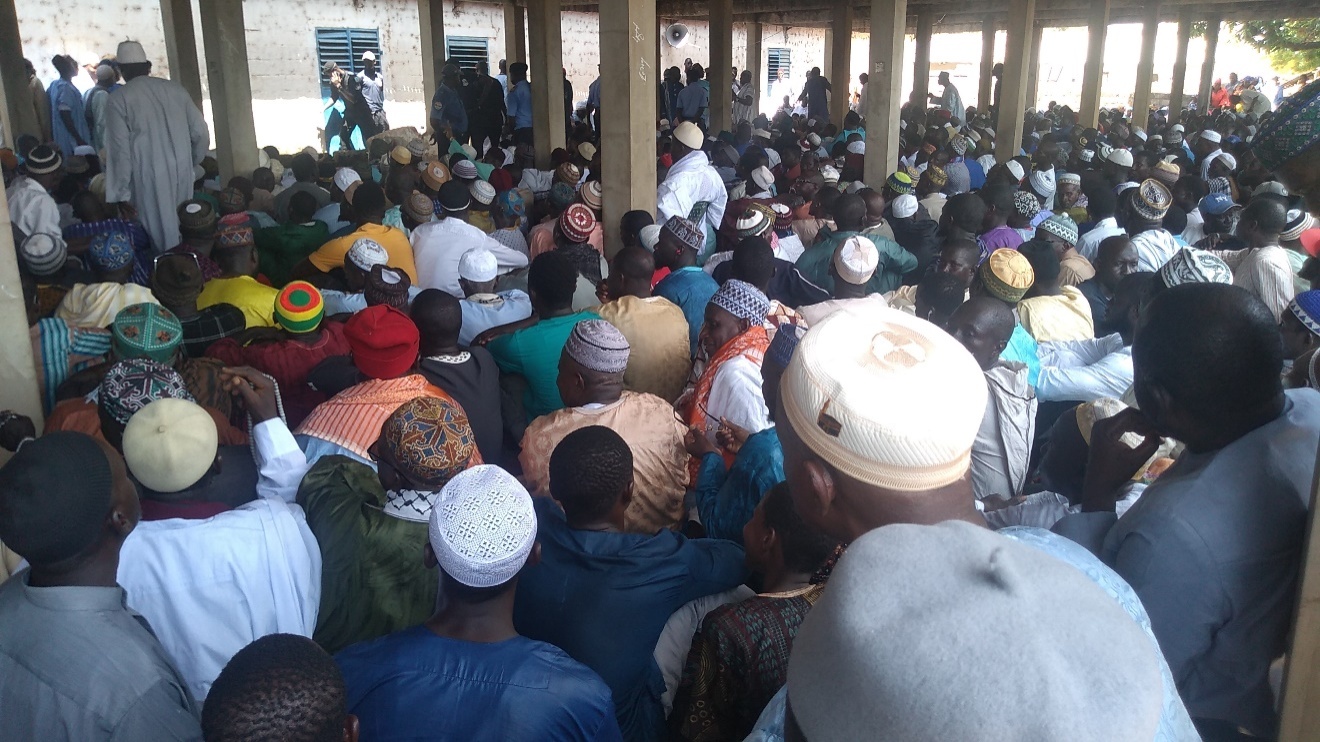(Part 2)
As mentioned in Part 1, you may leave Muzdalifah after midnight, especially if your family is accompanying you on Hajj. If you are strong and young, you may follow the Prophet’s Sunnah, spending the whole night in Muzdalifah and praying the Fajr Prayer there. After Fajr, the Prophet headed to Al-Mash`ar Al-Haram, supplicated Allah until the twilight became clear, and then moved to Mina before the sun rose.
After arriving at Mina, there are four rituals to do:
1. Throwing the pebbles
2. Slaughtering the hadi animal
3. Shaving or cutting the hair
The first ritual on Dhul-Hijjah 10 is to throw pebbles at Jamrat Al-`Aqabah, also called Al-Jamarat Al-Kubra.
Seven pebbles (not bigger than beans) should be thrown into the Jamrah basin. You may collect the pebbles from Muzdalifah or from wherever you like, but do not use the pebbles thrown by other pilgrims. It is a good idea to collect all the pebbles you will use throughout the three or four days (Dhul-Hijah 10-13). If you intend to spend three days in Mina after the day of `Eid, then you will need 70 pebbles. If you intend to spend just two days after `Eid, then you need only 49 pebbles.
The Prophet threw the pebbles when he reached Mina after sunrise of Dhul-Hijjah 10. Women and weak persons are allowed to spend half the night in Muzdalifah and then go to Mina, where they are allowed to throw the pebbles when they arrive, even if it is before the Fajr Prayer of Dhul-Hijjah 10. The time of throwing pebbles extends until the Fajr Prayer of Dhul-Hijjah 11.
When throwing the pebbles, make sure that they fall in the basin of the Jamrah. The pillar of the Jamrah is merely a sign indicating the throwing place. So hitting the pillar is not required. Actually, a pebble hitting the pillar and not falling in the basin is not counted. It is recommended to say “Bismillah, Allahu Akbar” when throwing each pebble.
Note the Following
Cease reciting Talbiyah when you start throwing pebbles. From now on repeat the Takbir of `Eid:
Allahu Akbar, Allahu Akba, La ilaha illa Allah
Wallahu Akbar, Allahu Akbar, wa lillahi al-hamd.
Allah is the Greatest, Allah is the Greatest, there is no god but Allah. And Allah is the Greatest, Allah is the Greatest, and to Him belongs all praise.
Take extra pebbles with you. It may happen that one or more pebbles miss the basin.
Never take luggage with you. Tragic stampede accidents occurred in the past years because luggage blocked the way.
Try to choose suitable times. Never try to throw pebbles when the place is crowded. Take care of your money and important documents when going to throw pebbles and in any crowded place. Unfortunately, some thieves do not care for the sacredness of the place and time of Hajj and exploit such big gatherings in robbing the pilgrims.
If you lose your shoe, never bend down to take it. This could put you in a serious risk of being trampled.
2. Slaughtering the Hadi Animal
People who perform tamattu` or qiran Hajj are required to slaughter an animal and give it as a gift for the poor of Makkah. This animal is called hadi. The animals that can be slaughtered as hadi are sheep, goats, cows, and camels.
One sheep or one goat is enough for one person; whereas seven persons can share in one cow or camel. You may eat part of your hadi, give part of it as a gift to whomever you like, and distribute the rest among the poor of Makkah. According to some scholars, at least half of the hadi should go to the poor. You may not give the butcher any part of the hadi in lieu of his wage.
The following conditions should be met in your hadi:
A goat should be no less than 1 year old; a sheep no less than 6 months on condition that it is fat; a cow no less than 2 years; and a camel 5 years.
The animal should be healthy and free from physical defects. It should not be one-eyed, limping, mangy, or very thin and weak. You may find it difficult to slaughter and distribute the hadi meat. So the Islamic Development Bank has set up booths around Makkah and Mina to facilitate the purchase of coupons for slaughtering and distributing hadi animals.
3. Shaving or Cutting Hair The next step is to shave or cut your hair. A woman is required to gather her hair and cut a small amount from the end of it. In Mina, there are places reserved for barbers near the Jamarat where you can have your hair shaved or cut. Women can cut their hair in their tents by themselves or with the help of other women or mahrams.
After throwing the pebbles and shaving or cutting your hair, you are partially absolved of the state of ihram and may change into other clothes. All the restrictions of ihram cease to be in effect with one exception: intimate relations with your spouse. This restriction remains in force until you make Tawaf Al-Ifadah.
4. Tawaf Al-Ifadah The last ritual on Dhul-Hijjah 10 is making Tawaf Al-Ifadah. This Tawaf is an indispensable pillar of Hajj. It differs from the Tawaf of `Umrah in two things:
1. There is no idtiba` (exposing the right shoulder for men) in it, simply because people in this Tawaf do not wear ihram. They are permitted to wear their ordinary clothes after throwing the pebbles and shaving or cutting their hair.
2. There is no ramal (jogging) in it. Otherwise, it is done in the same way Tawaf of `Umrah is done. It is recommended to perform Tawaf Al-Ifadah on Dhul-Hijjah 10, especially if women fear that their period might start before they make Tawaf. Yet it is acceptable to delay it until before leaving Makkah; in this way you need not also make Tawaf Al-Wada` (Tawaf of leaving or Farewell Tawaf). If you are performing tamattu` Hajj, you need not to make Sa`i after Tawaf Al-Ifadah.
The Sa`i of `Umrah is enough. Some scholars, however, deem it recommended to make a second Sa`i. If you are performing ifrad or qiran hajj and you have already made Sa`i after the Tawaf of arrival, you also need not make another Sa`i. If you did not make Sa`i after the Tawaf of arrival, you have to make it after Tawaf Al-Ifadah.
5. Leaving to Mina After making Tawaf Al-Ifadah (and Sa`i if you have not made it after ther Tawaf of Arrival), you are totally absolved form the state of ihram. All the restrictions of ihram, including intimate relations with your spouse, are no longer applicable to you. You then leave to Mina where you spent the night.

How to Make Hajj (Part 3)
After finishing the rituals of the first day of `Eid, you are done with the major rituals of Hajj – the pillars of Hajj – and therefore you are totally absolved of the state of ihram. These rituals of Hajj remain:
1. Spending two or three nights in Mina
2. Throwing the pebbles
3. Making the Farewell Tawaf
- Spending Nights in Mina
You have to spend two or three nights following the first day of `Eid in Mina. If you intend to spend just two nights in Mina, you have to leave before the Maghrib Prayer of Dhul-Hijjah 12.
Throughout the three days following the first day of `Eid you are not obliged to stay in Mina in the daytime, yet staying in Mina is the sunnah. These three days are called the Days of Tashreeq. The Prophet (peace and blessings be upon him) is reported to have said, “The Days of Tashreeq are days of eating, drinking, and remembering Allah.” It is recommended, therefore, that you repeat the Takbir of `Eid throughout these days, especially after each prayer.
- Throwing Pebbles at the Three Jamarat
On each day of Dhul-Hajjah 11-13, you throw pebbles at the three Jamarat, starting with the small Jamarah (Al-Jamarat As-Sughra), then the middle one (Al-Jamarat Al-Wusta), and finally the big Jamarah (Al-Jamarat Al-Kubra). The time for throwing the pebbles starts from the Fajr Prayer of each day and extends to the next day’s Fajr Prayer. Some people insist that the time for throwing the pebbles starts after Zhuhr Prayer; this is the opinion of some scholars but it is a weak one. Furthermore, it poses a great difficulty on both pilgrims and Saudi authorities because of the huge number of pilgrims.
Throw seven pebbles into the basin of each Jamarah, saying “Bismillah, Allahu Akbar” when throwing each pebble. After finishing the first jamarah (the small one), it is recommended that you stand and supplicate Allah Almighty as long as you can. It is recommended that you also do so after you finish the second jamarah (the middle one).
If you plan to spend only two days and nights in Mina, you throw the pebbles on Dhul-Hijjah 11 and 12 only.
- Making the Farewell Tawaf Now that you are going to leave the sacred sites, you have to bid farewell to the sacred mosque and refresh your eyes with the sight of the Ka`bah before departing.
This is done by performing Tawaf Al-Wada` (Farewell Tawaf), which you should do immediately before leaving Makkah. This Tawaf is performed in the same way as Tawaf Al-Ifadah; no idtiba` (exposing the right shoulder) or ramal (jogging) is involved.
You may prefer to delay Tawaf Al-Ifadah until you are about to leave Makkah. This practice is acceptable, but note that the intention of this Tawaf should be that it is Tawaf Al-Ifadah. After finishing it, you need not make another special Tawaf for leaving.
A menstruating woman need not make the Farewell Tawaf so long as she has already made Tawaf Al-Ifadah. But if she has not made Tawaf Al-Ifadah yet, she has to stay until she is pure and performs ghusl (ritual bathing) and then she can make Tawaf Al-Ifadah (which would serve also as the Farewell Tawaf if she leaves directly after it). If such waiting would pose an unbearable difficulty on her, for example if she would miss her flight, she is allowed to make Tawaf Al-Ifadah even if she has her period. This opinion is held by the prominent scholars Ibn Taymiyah and Ibn Al-Qayyim and is preferred by Dr. Yusuf Al-Qaradawi.




